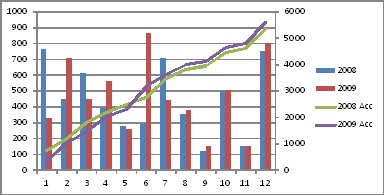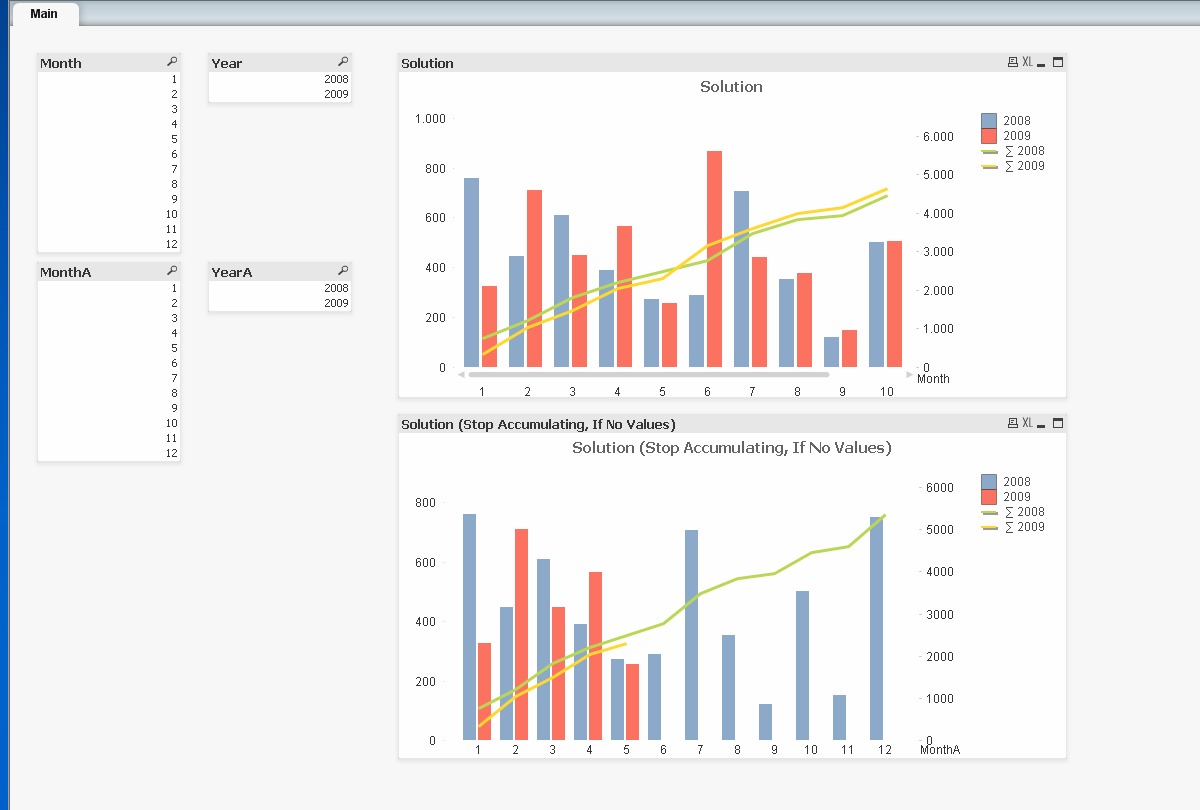Unlock a world of possibilities! Login now and discover the exclusive benefits awaiting you.
- Qlik Community
- :
- All Forums
- :
- QlikView App Dev
- :
- Re: Chart Accumulation (with Dimensions)
- Subscribe to RSS Feed
- Mark Topic as New
- Mark Topic as Read
- Float this Topic for Current User
- Bookmark
- Subscribe
- Mute
- Printer Friendly Page
- Mark as New
- Bookmark
- Subscribe
- Mute
- Subscribe to RSS Feed
- Permalink
- Report Inappropriate Content
Chart Accumulation (with Dimensions)
Hi
I am trying to create a chart that has bars for monthly sales (the chart has the primary dimension Month and the secondary dimension Year). Also, I want the same chart to show the accumulated sales as a line (but true to the dimensions, that is, QlikView should not accumulate for all years, but create accumulated sales per month for each year).
I have tried to setup an example of what I want, and how I have tried to solve the problem... Could anyone take a look at the attached file and help me figure out what is going on, and how I best solve the problem? I really don't understand why my set analysis is not working...
Thanks
Simon
Excel Example

PS: I updated this discussion with an Excel file of what the chart should look like...
Accepted Solutions
- Mark as New
- Bookmark
- Subscribe
- Mute
- Subscribe to RSS Feed
- Permalink
- Report Inappropriate Content
Hi Simon,
Good Attempt of Set Analysis. But your expression is wrong. That's why you get error result.
Sum({1<Year={'=Max(Year)-1'}>}Sales) - Your expression
Sum({<Year={$(=Max(Year)-1)}>}Sales) - Correct Expression
Sum({1<Year={'=Max(Year)'}>}Sales) - Your Expression
Sum({<Year={$(=Max(Year))}>}Sales) - Correct Expression.
The reason i removed 1 is, it will exclude the selection.
Try this. It is working.
Regards,
Srini.
- Mark as New
- Bookmark
- Subscribe
- Mute
- Subscribe to RSS Feed
- Permalink
- Report Inappropriate Content
Hello Simon,
take a look at the chart I derived from your first guess. May be you want to replace my hardcoded years with a variable.
Regards, Roland
- Mark as New
- Bookmark
- Subscribe
- Mute
- Subscribe to RSS Feed
- Permalink
- Report Inappropriate Content
Hi Simon,
Good Attempt of Set Analysis. But your expression is wrong. That's why you get error result.
Sum({1<Year={'=Max(Year)-1'}>}Sales) - Your expression
Sum({<Year={$(=Max(Year)-1)}>}Sales) - Correct Expression
Sum({1<Year={'=Max(Year)'}>}Sales) - Your Expression
Sum({<Year={$(=Max(Year))}>}Sales) - Correct Expression.
The reason i removed 1 is, it will exclude the selection.
Try this. It is working.
Regards,
Srini.
- Mark as New
- Bookmark
- Subscribe
- Mute
- Subscribe to RSS Feed
- Permalink
- Report Inappropriate Content
Hi Roland & Srinivasan
Thanks for your replies... Both solutions were good. I didn't even think to try an If-expression. But I think I will go with Srinivasan's solution as I will need to discard any selections, and keep the '1'. ![]() I don't understand why I need both an equal sign and $() inside my set analysis..? Shouldn't the equal sign be enough..? Well, it is working, so I will just remember to use your syntax, Srinivasan.
I don't understand why I need both an equal sign and $() inside my set analysis..? Shouldn't the equal sign be enough..? Well, it is working, so I will just remember to use your syntax, Srinivasan.
Thanks for helping out...
// Simon
PS: I have attached my final solution, which also cuts off accumulation for months, which are not present as discussed elsewhere in the community.

- Mark as New
- Bookmark
- Subscribe
- Mute
- Subscribe to RSS Feed
- Permalink
- Report Inappropriate Content
Hi Simon,
To answer you question "why I need both an equal sign and $() inside my set analysis..?"
In Set analysis the expression inside set should be within $ i.e., "$(=Max(Year)-1)".
The reason for equal sign inside the $ is it compute the expression and $ will return the value.
I hope this will be clear for you.
Regards,
Srini.